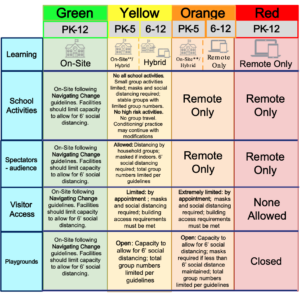Middle and high school students in the Spring Hill School District are heading back to school in-person starting Feb. 1. The board tossed its gating criteria and agreed to allow parents the option of whether to send their kids to school buildings or continue with virtual learning.
With that decision, the Spring Hill district is the only Johnson County school district without published gating criteria related to COVID-19.
Several school districts across the state last summer adopted gating criteria to determine when it is safe for kids to return to classrooms. Guided by recommendations from the Kansas Department of Health and Environment, county health departments, and national and international disease control organizations like the Centers for Disease Control, school boards debated adopting color-coded gating criteria using metrics like absenteeism rates, incidence rates, local hospital capacity and rolling positivity rates. For example, Johnson County health department’s color-coded gating criteria puts the county in a red zone.
The gating criteria was (and remains aside from Spring Hill) arbitrarily determined, which many parents suggest was done with a focus of keeping kids out of school than safely education them.
Gating criteria metrics include positivity rates
A red zone means there are 251 or more new cases per 100,000 county residents over the last two weeks and a positivity rate of more than 15% of those tested over the past two weeks. When first adopted, the county health department recommended that all students — elementary and secondary — attend school virtually.
Despite the red zone, all Johnson County school districts allow elementary students to attend in-person. Many districts changed their gating criteria in order to allow older students to attend in-person in some capacity. For instance, the Johnson County health department last October changed the way it figures positivity rates. The county was dividing the number of positive cases by the number of individuals tested. This meant that individuals testing positive returning for second tests counted every time they tested positive. In October, the county began dividing the number of positive cases by the number of individuals testing. It immediately dropped the county’s positivity rate from 11.3% to 6.6%. The change prompted some school districts to allow hybrid learning modes for middle and high school students.
In Reno County, officials tweaked school gating criteria to exclude the positive tests among prison inmates and initiated plans to test 1,000 asymptomatic individuals per week hoping to drive down positivity rates to a level that allowed in-person schooling.

The KDHE recommended gating criteria for full-time, in-person learning requires a 14-day positivity rate below 5%. Currently, the statewide positivity rate is 7.25%, and the Johnson County positivity rate is 5.87%.
Students plead to go to school
Spring Hill board of education members decided to throw out gating criteria altogether. Pleas from students, who begged board members to allow them to return to in-person learning, helped persuade the board.
“I never thought I would have to fight to go to school, and I certainly never thought I would have to stand before you yet again and try to convince you to let us in,” Kailey Howell, a middle school student, said. “…You have so many students begging you to put us back in school. So many are not here because they have lost the will to try, and you have given up on them.”
Another student, senior Emily Dowd, said removing kids from school is ridiculous, noting that the neighboring Louisburg district has been in-person since the school year started.
“It is heartbreaking to know that some teachers are liking online school,” Dowd said. “This is your job. No one said it would be easy. If you want students to thrive, put us back into school. It is not as complicated as you think… To ignore (students’) wants and needs is selfish and cruel.”
More than two dozen individuals, including teachers, students, and state lawmakers, addressed the board Monday night. Most pleaded for reopening schools.
Parent, teacher group opposes eliminating gating criteria
Shay Link said the board betrayed the public trust by abolishing gating criteria for reopening. She said she spoke on behalf of more than 75 teachers and parents.
“I’m here to speak to you about trust and commitment. As parents and teachers, we are tired. We are tired of asking the board to abide by their pillars of trust to have their collective character and commitment to do what is right… We are a group that is disappointed that it is easier to give in to the loudest voices in this debate than to commit to the gating criteria that this board created,” Link said. “We are a group that is not sure if we will ever be able to trust future policies from this board.”
Wayne Burke, Spring Hill Superintendent, prepared a document for navigating reopening without gating criteria. He was careful not to encourage or discourage changes to the gating criteria.
“In order to be proactive, I met with secondary administrators and some teachers to discuss a recommendation to reduce stress, ensure safety and enhance operations if the (board of education) makes a change or eliminates the gating criteria,” Burke’s memo to the board reads.
Spring Hill middle and high school students return to classrooms on Feb. 1, but parents who enrolled kids in remote learning can continue virtual schooling. In-person learning will require masking, extra cleaning, social distancing, temperature checks, and contact tracing. JCDHE quarantine and contact tracing guidelines still apply, but parents should know that contact tracing cannot be mandatory under state law.



